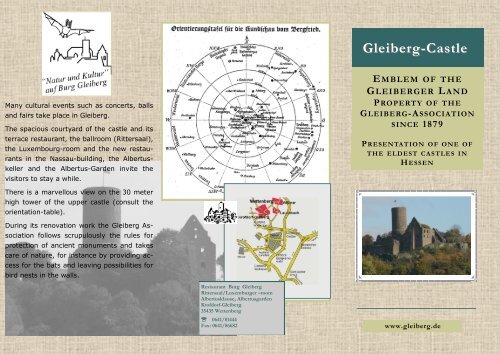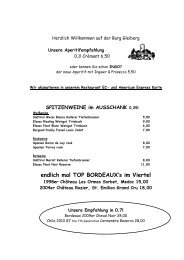Gleiberg-Castle - Gleiberg-Verein
Gleiberg-Castle - Gleiberg-Verein
Gleiberg-Castle - Gleiberg-Verein
Create successful ePaper yourself
Turn your PDF publications into a flip-book with our unique Google optimized e-Paper software.
<strong>Gleiberg</strong>-<strong>Castle</strong><br />
Many cultural events such as concerts, balls<br />
and fairs take place in <strong>Gleiberg</strong>.<br />
The spacious courtyard of the castle and its<br />
terrace restaurant, the ballroom (Rittersaal),<br />
the Luxembourg-room and the new restaurants<br />
in the Nassau-building, the Albertuskeller<br />
and the Albertus-Garden invite the<br />
visitors to stay a while.<br />
E MBLEM OF THE<br />
G LEIBERGER LAND<br />
P ROPERTY OF THE<br />
G LEIBERG-ASSOCIATION<br />
SINCE 1879<br />
P RESENTATION OF ONE OF<br />
THE ELDEST CASTLES IN<br />
H ESSEN<br />
There is a marvellous view on the 30 meter<br />
high tower of the upper castle (consult the<br />
orientation-table).<br />
During its renovation work the <strong>Gleiberg</strong> Association<br />
follows scrupulously the rules for<br />
protection of ancient monuments and takes<br />
care of nature, for instance by providing access<br />
for the bats and leaving possibilities for<br />
bird nests in the walls.<br />
Restaurant Burg <strong>Gleiberg</strong><br />
Rittersaal/Luxemburger –room<br />
Albertusklause, Albertusgarden<br />
Krofdorf-<strong>Gleiberg</strong><br />
35435 Wettenberg<br />
0641/81444<br />
Fax: 0641/86682<br />
www.gleiberg.de
T HE COUNTS OF G LEIBERG<br />
(1000 to 1170)<br />
Count Frederic 1 from Luxembourg probably was the first<br />
who built fortifications of the 308 meters high hill. You still<br />
can recognize the ground walls of the quadrangular tower.<br />
Frederic 1 and his successors founded the dynasty of the<br />
counts of <strong>Gleiberg</strong> who have close links with the powerful of<br />
the German empire. Kunigunde , a sister of Frederic 1, who<br />
probably was born in the castle of <strong>Gleiberg</strong>, married the emperor<br />
Henry 2. The castle of <strong>Gleiberg</strong> plays then an important<br />
part in the political life of the empire in the eleventh and<br />
twelfth centuries.<br />
The county of <strong>Gleiberg</strong> stretches from the Land-Valley between<br />
Giessen and Wetzlar to Marburg in the North and<br />
reaches Weilburg and the beginning of the Lumda-Valley up<br />
to Buseck and Hüttenberg. In 1103, the future emperor<br />
Henry the fifth tears down the upper castle. From then<br />
on and with the division of the castle and the county which<br />
follows, <strong>Gleiberg</strong> looses much of its political influence and<br />
military interest. Other remains in the region built by the<br />
counts of <strong>Gleiberg</strong> (around 1100) are the Vetzberg-castle, the<br />
abbey of Schiffenberg (1129) and the water castle of Giessen<br />
(1150).<br />
THE LORDS OF MERENBERG<br />
(1170 to 1333)<br />
They built the important monument of Merenberg and included<br />
the lower courtyard inside the moats. In 1331, the<br />
<strong>Gleiberg</strong> settlement which grew around the castle was<br />
surrounded by a wall and received from the emperor<br />
Ludwig the fourth the privileges of an autonomous settlement<br />
like Frankfort. The population consisted then<br />
mainly of officers, horsemen and servants of the castle<br />
Lords.<br />
THE HISTORY AND THE OWNERS OF THE GLEIBERG-CASTLE<br />
THE COUNTS OF NASSAU<br />
(1333 to 1816)<br />
Through marriage the <strong>Gleiberg</strong> fell in the possession of the<br />
Counts of Nassau . Thus lost its destination of a residence<br />
and was downgraded to a far away administrative post on<br />
the frontier of the Nassau estates. Nevertheless the upper<br />
castle was continuously extended by fortifications. After<br />
1575 the lower castle was built including the Albertushouse<br />
and the Nassau-building which was used by the<br />
officers and the knights as secondary residence, it became<br />
the restaurant today. In 1646 the upper castle was destroyed<br />
and lost all military and political importance.<br />
From then on the nearby inhabitants used it as a quarry. The<br />
lower castle as well is abandoned and only used as warehouse<br />
for the grain requested by the prince and falls near<br />
ruin.<br />
THE STATE OF PRUSSIA<br />
(1816 to 1879)<br />
The decisions made by the Congress in Vienna changed completely<br />
the map of Europe and affected also the <strong>Gleiberg</strong> which<br />
became a part of Prussia. In 1837 the "Association for the<br />
building of a staircase” in the tower of the <strong>Gleiberg</strong> ruins<br />
came into life. Thanks to them, an entrance was opened into<br />
the 4 meter thick wall of the castle and a wooden staircase was<br />
constructed 1879 inside the tower. The first visitors came in<br />
September 1879, however the Prussian administration did not<br />
succeed in selling the <strong>Gleiberg</strong> as a profitable monument.<br />
THE "GLEIBERG-VEREIN"<br />
-responsible for the castle since 1879-<br />
In September 1879, the <strong>Gleiberg</strong>-Association becomes owner<br />
and commits itself to stop further decay, to undertake the necessary<br />
consolidation works and to open the monument to the<br />
public. This is the task the association fulfils still today.<br />
Following events were important:<br />
1880 to 1945:<br />
The dwellings of the lower castle were cleaned from rubble<br />
and renovation proceeded all over the place. In the kitchen<br />
of the "Albertus-house" which is called today<br />
"Albertusklause" a pub was opened. More rooms were built<br />
for residence and receptions 'Rittersaal". The courtyard of<br />
the castle was redone and levelled. So the castle became rapidly<br />
an attractive destination for excursions. During the national-socialist<br />
time, the <strong>Gleiberg</strong>-Association did succeed in<br />
keeping the <strong>Gleiberg</strong> its property.<br />
1950 to 1982:<br />
The Association collected plenty of money by leasing the<br />
restaurant. This money was reinvested mostly in the renovation<br />
of the lower castle: The courtyard was redesigned, parking<br />
space was created along the access road. Consolidation<br />
work is also done in the upper castle, particularly in the roof<br />
structure of the Merenberg-house, in the ruins of the tower<br />
and the walls. The wooden staircase of the tower is replaced<br />
by a concrete staircase.<br />
1983 to 1994:<br />
The ruins of the former premises and the walls of the upper<br />
castle which threatened to crumble were restored at a cost of<br />
more than 2 million DM. A round-path was opened to the<br />
public inside the upper castle as well as other improvements<br />
which make it more attractive to the public.<br />
Since 1995:<br />
The activity of the Association concerns mainly the lower<br />
castle. In the years 1995 to 1999 the house-techniques were<br />
modernized and in 2000-2001 the roofs and wooden structures<br />
of the attic are renovated. The rooms are newly decorated<br />
and the old entry to the upper castle was restored in<br />
2003-2004, part of the courtyard was paved and a garden, the<br />
"Albertus Garden", was created. The expenses for all those<br />
works amounted to 1,5 million €.



